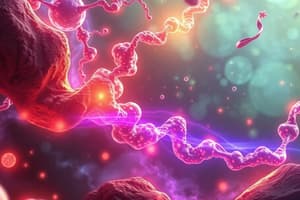Podcast
Questions and Answers
What is the key intermediate for semi-synthetic protocols in the synthesis of cephalosporins?
What is the key intermediate for semi-synthetic protocols in the synthesis of cephalosporins?
- Cephalosporin C
- 6-APA
- 7-ACA (correct)
- Penicillin G
Which of the following aims is NOT associated with modifications of the chemical structure of cephalosporins?
Which of the following aims is NOT associated with modifications of the chemical structure of cephalosporins?
- Broaden the antibacterial spectrum
- Improve acid stability
- Decrease the activity (correct)
- Increase the affinity to the receptors (PBPs)
What is the mechanism of action of cephalosporins on bacterial cells?
What is the mechanism of action of cephalosporins on bacterial cells?
- Inhibition of bacterial RNA transcription
- Inhibition of bacterial protein synthesis
- Inhibition of bacterial DNA replication
- Inhibition of the transpeptidase enzyme (correct)
Which of the following statements is true regarding the structure of cephalosporins compared to penicillins?
Which of the following statements is true regarding the structure of cephalosporins compared to penicillins?
Which of the following is a reason for the limited opportunity for modification in cephalosporins?
Which of the following is a reason for the limited opportunity for modification in cephalosporins?
Which of the following is NOT a reason for making modifications to the chemical structure of cephalosporins?
Which of the following is NOT a reason for making modifications to the chemical structure of cephalosporins?
Which modification enhances outer membrane penetration in third generation cephalosporins?
Which modification enhances outer membrane penetration in third generation cephalosporins?
Which of the following best describes the relationship between substituents at position 3 and pharmacokinetics?
Which of the following best describes the relationship between substituents at position 3 and pharmacokinetics?
Which of the following best describes the stability of first generation cephalosporins compared to penicillins?
Which of the following best describes the stability of first generation cephalosporins compared to penicillins?
Which of the following best describes the role of oximino groups in cephalosporins?
Which of the following best describes the role of oximino groups in cephalosporins?
Which of the following is a significant factor in the activity of each type of cephalosporin?
Which of the following is a significant factor in the activity of each type of cephalosporin?
Which of the following is a characteristic of fifth generation cephalosporins?
Which of the following is a characteristic of fifth generation cephalosporins?
Which of the following best describes the relationship between metabolic deacetylation and activity in cephalosporins?
Which of the following best describes the relationship between metabolic deacetylation and activity in cephalosporins?
Which of the following best describes the role of EWGs at the acyl side chain in cephalosporins?
Which of the following best describes the role of EWGs at the acyl side chain in cephalosporins?
Which of the following is a characteristic of cephamycins?
Which of the following is a characteristic of cephamycins?
Which of the following best describes the relationship between the acetoxy group and the mechanism of action in cephalosporins?
Which of the following best describes the relationship between the acetoxy group and the mechanism of action in cephalosporins?
Flashcards are hidden until you start studying
Study Notes
Cephalosporins: Classification
- Around 50 cephalosporins are in clinical use
- Classification into generations is based on:
- Spectrum of anti-bacterial activity
- Chemical sophistication
- Chronology
First Generation Cephalosporins
- Cephalothin was one of the most commonly used
- Importance of acetoxy group in the mechanism of action
- Note: acid and alcohol can react to give a lactone
- Cephaloridine:
- Esterase stable pyridinium group
- Exists as a zwitterion, but poorly absorbed
Improvements in First Generation
- Improve stability: EWGs at carbon a to side chain amide
- Improve oral absorption: methyl group at position-3
Second Generation Cephalosporins
- Cephamycins: methoxy group at position-7
- Cefoxitin has a broader spectrum of activity compared to 1st generation
- Oximinocephalosporins: modification a to side chain amide increases stability against β-lactamases
Third Generation Cephalosporins
- Aminothiazole ring enhances outer membrane penetration (Gram-negative)
- Substituent at position 3 varies pharmacokinetics
- Major role due to activity against Gram-negative bacteria
Fourth Generation Cephalosporins
- Still oximinocephalosporins, but are zwitterionic
- Dramatically improves outer membrane penetration
- Good affinity for transpeptidase, low for a variety of β-lactamases
Fifth Generation Cephalosporins
- Approved in 2014
- Urea Pyrazole ring
- Ceftolozane
- Effective against MRSA, MDRSP, and P. aeruginosa
Resistance and Activity
- Activity of each type of cephalosporin depends on:
- Ability to reach the bacterial transpeptidase
- Stability to β-lactamases present
- Affinity for the target enzyme
- Example: Cephalosporins and MRSA
Cephalosporins: Summary
- Strained β-lactam ring fused to dihydrothiazine ring
- 1st generation vs penicillins:
- Better stability against acid and β-lactamases
- Poor oral availability and lower activity
- Variation at 7-acylamino side chain alters activity
- Variation at position 3 alters pharmacokinetics/metabolism
- Methoxy groups can be added at C-7
- Synthesis: semi-synthetic procedures from 7-ACA
- 7-ACA obtained by chemical hydrolysis of cephalosporins requires prior activation of the side chain
Other β-Lactam Antibiotics
- Carbapenems: potent, very broad range of activity, low toxicity, and highly resistant to β-lactamases
- Example: Thienamycin (1976)
- Monobactams: isolated from natural sources, surprising structures
Studying That Suits You
Use AI to generate personalized quizzes and flashcards to suit your learning preferences.




